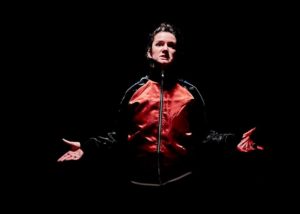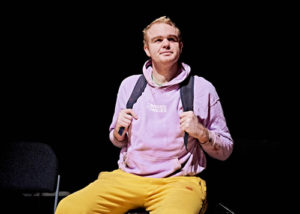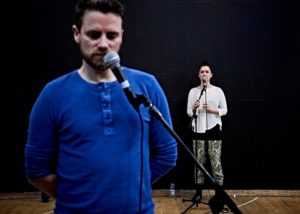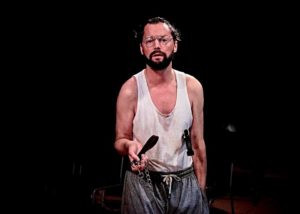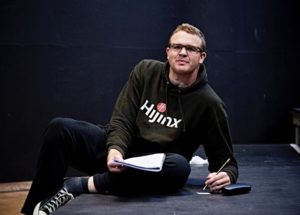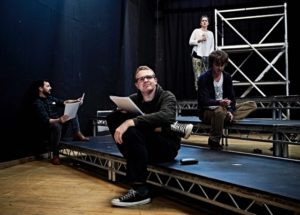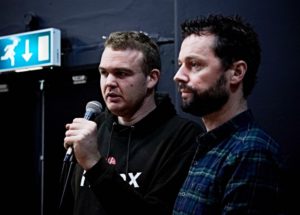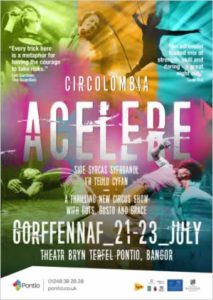 (2 / 5)
(2 / 5)
August 012 performs John Steinbeck’s Of Mice and Men for laughs and misses the mark by a country mile!
Introduction and Background
John Steinbeck’s classic 1937 novella was a new genre of work that Steinbeck invented. In his own words, it was strictly, neither a novel or a play, but a play/novelette. In his eyes, he recognised that the novel was in a moribund state, but theatre was “coming alive”. This genre used chapters for curtains and is scened in such a way that it can directly be transformed into a play. He eventually decided to write a play, “in the physical technique of a novel.”
The story is about two itinerant farm workers who travel the road looking for work during the Great Depression of the United States in the early 1930’s. Steinbeck was born and brought up in Salinas in California, and he witnessed the impact of over 300,00 migratory workers from the Dust Bowl states of Oklahoma and primarily and other prairie states had on his part of California.
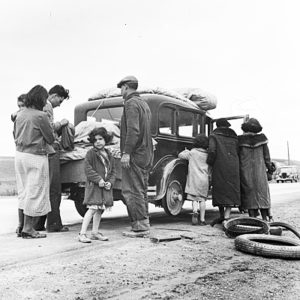
The two workers, George who is intelligent and worldly but uneducated, and Lenny, his mentally disabled companion. They both dream of living in a better place in a better world, but their destinies are realised when they arrive to work at a plantation.
It is easy to relate this to the current situation in South Wales in terms of disillusionment and lack of hope, the displacement of individuality. The explosion of migratory workers suggests, (without the nationalistic connotations), to the reasons why many people voted for Brexit last year. So, it’s an ideal play to put on in this location and social climate.
The first production of the play, at the Theater Union of San Francisco opened to favourable reviews on 21st May 1937 and shortly afterwards. it opened on Broadway, with legendary actor Broderick Crawford as Lenny.
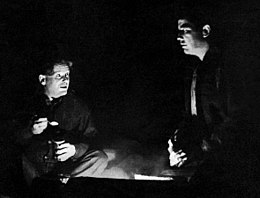
If you look at the photograph of Lenny and George above, one thing that strikes me is that it heightens the claustrophobic intensity which is a feature of both the play and the novel. George and Lenny are trapped in their own sad world, and this has to be an essential feature of any production of Of Mice and Men.
August 012 Production Of Mice and Men
CAST
Anthony Corria; Sara Gregory; Neal McWilliams; Tom Mumford; Wil Young
All actors, with the exception of the two protagonists, George (McWilliams) and Lenny (Young) play multiple parts.
Director: Mathilde Lopez
Set Design: Tina Torbey
Lighting: Ace McCarron
Sara Gregory
Wil Young
Anthony Corria
Production Design
Just before entering the auditorium, I had a brief conversation with a member of the production team. The show had been sold out for its entire run, so, due to its popularity, I asked her whether it would tour. She answered in the negative, saying that the production was an expensive one due to the stage design, and it had been tailor made for the venue. So, then I asked her whether it would be brought back later on and she stated that this is a possibility, due to the demand from local schools, many of which were unable to be catered for during the run. I also overheard her say that this production had drawn from both the book and play sources.
Upon entering the space, I could see why touring is an impossibility. The stage had been crafted in such a way that it fitted the shape of the auditorium and could not be easily adapted to another space . There is no central stage, and effectively, it is a theatre in the round, with audience seated on each side.
Located in roughly all four corners were microphones and a dozen lampshades, some lit are overhead. Wide spaces between the rows of seat, enables the actors to move freely around. This results in a slightly negative way for you either have to turn your ahead around to see all of the action, or use your imagination.
The Show
When the play starts, Lenny and George are speaking to each other using the microphones and at diagonally opposite sides of the auditorium. This destroys the intimate, claustrophobic essential feature of the story immediately.
There is a great deal of audience participation in the production. This is fun, but, again, distracts from being focused on George and Lenny’s enclosed existence. It all gets rather manic from time to time.
However, My main criticism is based upon the way that the dreaming of a better world is played. Using a filmic technique, or at least, this is the impression it left on me, George spoke into his microphone with background music and such a way it parodied either Hollywood or itself. At times, George reminded me of a demented evangelist.
This technique is used to better effect when the only female in the story, Curley’s wife speaks in a highly sensualised way.
Another example where the integrity of the story is shattered is with the shooting of Candy’s dog. This is a very important segment of the story. Candy’s old sheepdog had outlived its usefulness and according to Carson’s blunt should be put down as it stunk out the bunkhouse. The death foreshadows Lenny’s shooting by George at the story’s finale and also symbolises, through a developing pattern of creatures being crushed by Lenny, and ultimately, the fate of the rabbits and via, the fate of the Safe House”, the idealised world that the protagonists and Candy dream of.
The part of the dog is selected by a random member of the audience, who is led off stage to its fate. The audience member, naturally, looking a little embarrassed and smiling nervously, trudges off to the great amusement of everyone, thereby killing the dramatic impact. I didn’t hear a shot offstage, which might have readdressed the balance. Candy, later returns with copious amount of blood on his hands and the audience dog “actor” returns to his seat.
Neal McWilliams, (George) is the pick of the actors on display and Sara Gregory provides some nice cameos. She has to play both Curley and his wife, and if I am not mistaken, the role of Candy is played by two different members of the cast. This is a little confusing, but difficult to avoid with only five actors cast.
Another feature that didn’t work was the interchanging between the use of the microphone and natural voice within the same soliloquy. I didn’t see the point of this and I feel that it distracts from what is being said.
Summary
Of Mice and Men is a study of the hopes and dreams of men and of the necessity for men to have dreams. But these hopes and dreams are contrasted with the reality of the harsh world in which men must exist,
and the setting, costumes, lighting, and acting style must reflect this concept of contrast.
This is taken from a dissertation from undergraduate student Saralee O’Neill approved by the Graduate Faculty of Texas Tech University in 1985. It sums up my argument perfectly. Being innovative, which this production most certainly is, doesn’t necessarily make it good theatre. The integrity of the story and Steinbeck’s deep feelings on this subject have to be maintained. Steinbeck wrote what he felt and what he knew about firsthand.
I concede that this production is very entertaining. The majority of the audience were senior school students, and, in the most part, their attention was maintained throughout, which is a considerable achievement in itself. I have taught this novella at University in China, and I wonder whether the students really were truly informed about this work of literature based upon what they had watched. I am of the opinion, that they hadn’t.
If your “Theatre bag” is of the One Man, Two Guvnors ilk, then you will probably love this production, but Steinbeck – it ain’t.
The run ended on 28th October 2017, but may return.
Roger Barrington



